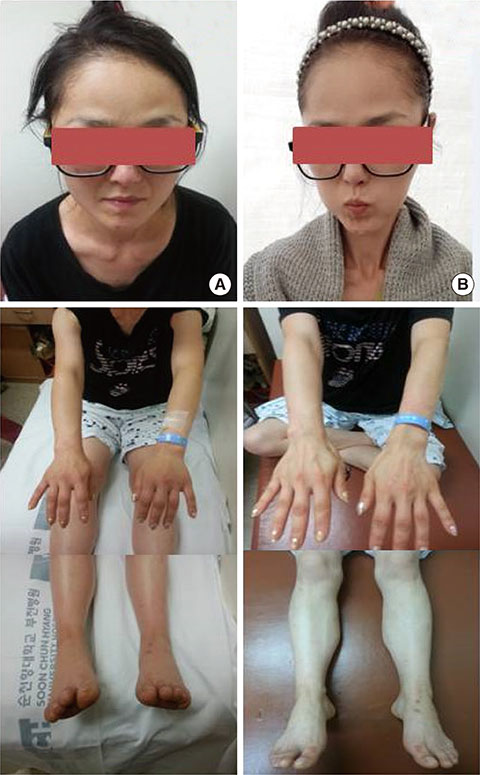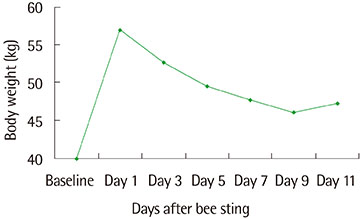Allergy Asthma Respir Dis.
2016 Jul;4(4):305-307. 10.4168/aard.2016.4.4.305.
Unusual reaction to Hymenoptera stings
- Affiliations
-
- 1Department of Internal Medicine, Soonchunhyang University Bucheon Hospital, Bucheon, Korea. jas877@schmc.ac.kr
- KMID: 2346762
- DOI: http://doi.org/10.4168/aard.2016.4.4.305
Abstract
- Reactions to Hymenoptera stings are classified into local reactions, large local reactions, systemic anaphylactic reactions, systemic toxic reactions, and unusual reactions. They are also classified into immediate and delayed reactions. The most frequent clinical patterns are large local and systemic anaphylactic reactions. The skin, and the gastrointestinal, respiratory, and cardiovascular systems can be involved. A variety of unusual or unexpected reactions, such as acute encephalopathy, acute renal failure, nephrotic syndrome, silent myocardial infarction, diffuse alveolar hemorrhage, rhabdomyolysis, and cataracts, occur in a temporal relationship to insect stings. Here, we report a 31-year-old woman with delayed generalized edema, weight gain, and unusual reactions 24 hours after bee sting.
Keyword
MeSH Terms
Figure
Reference
-
1. Koterba AP, Greenberger PA. Chapter 4: stinging insect allergy and venom immunotherapy. Allergy Asthma Proc. 2012; 33:Suppl 1. S12–S14.
Article2. Hamilton RG. Diagnosis and treatment of allergy to hymenoptera venoms. Curr Opin Allergy Clin Immunol. 2010; 10:323–329.
Article3. Müller UR. Insect venoms. Chem Immunol Allergy. 2010; 95:141–156.
Article4. Bilò MB. Anaphylaxis caused by hymenoptera stings: from epidemiology to treatment. Allergy. 2011; 66:Suppl 95. 35–37.
Article5. Bilo BM, Rueff F, Mosbech H, Bonifazi F, Oude-Elberink JN. EAACI interest group on insect venom hypersensitivity. Diagnosis of hymenoptera venom allergy. Allergy. 2005; 60:1339–1349.
Article6. Golden DB, Marsh DG, Kagey-Sobotka A, Freidhoff L, Szklo M, Valentine MD, et al. Epidemiology of insect venom sensitivity. JAMA. 1989; 262:240–244.
Article7. Mueller HL. Diagnosis and treatment of insect sensitivity. J Asthma Res. 1966; 3:331–333.
Article8. Ring J, Messmer K. Incidence and severity of anaphylactoid reactions to colloid volume substitutes. Lancet. 1977; 1:466–469.
Article9. Reisman RE. Unusual reactions to insect stings. Curr Opin Allergy Clin Immunol. 2005; 5:355–358.
Article10. Daher Ede F, da Silva Junior GB, Bezerra GP, Pontes LB, Martins AM, Guimaraes JA. Acute renal failure after massive honeybee stings. Rev Inst Med Trop Sao Paulo. 2003; 45:45–50.
Article11. Freye HB, Ehrlich B. Acute myocardial infarction following hymenoptera envenomation. Allergy Proc. 1989; 10:119–126.
Article12. Mukhopadhyay A, Fong KF, Lim TK. Diffuse alveolar haemorrhage: a rare reaction to insect sting. Respirology. 2002; 7:157–159.
Article13. Tanphaichitr VS, Tuchinda M. Severe thrombocytopenic purpura following a bee sting. Ann Allergy. 1982; 49:229–231.14. Goldstein NP, Rucker CW, Klass DW. Encephalopathy and papilledema after bee sting. JAMA. 1964; 188:1083–1084.
Article15. Mingomataj EC, Bakiri AH, Ibranji A, Sturm GJ. Unusual reactions to hymenoptera stings: what should we keep in mind? Clin Rev Allergy Immunol. 2014; 47:91–99.
Article
- Full Text Links
- Actions
-
Cited
- CITED
-
- Close
- Share
- Similar articles
-
- Two Cases of Oropharyngeal Edema Caused by a Bee Sting
- Management of Insect Sting Hypersensitivity: An Update
- A Case of Ant Sting by Crematogaster Matsumurai Vagala
- Human Sting of Cephalonomia gallicola (Hymenoptera: Bethylidae) in Korea
- Clinical Significance of Past History on the Preceding Reaction to Bee Sting and Specific IgE Antibody to Bee Venom in Patients with Bee Sting Anaphylaxis



